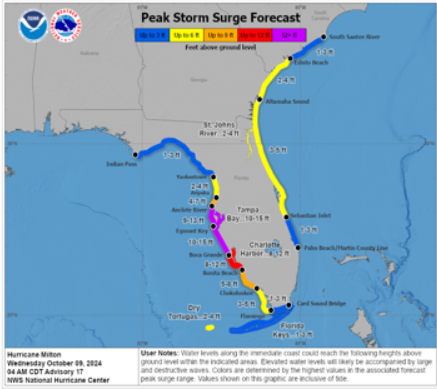Hurricane Milton, a powerful and rapidly intensifying storm, is set to make landfall on Florida's west-central coast late Wednesday or early Thursday as a Category 4 hurricane. As of Wednesday morning, Milton was still a formidable Category 5 storm, with sustained winds of 160 mph as it barreled toward the Gulf Coast. Forecasters from the National Hurricane Center (NHC) predict that while the hurricane may weaken slightly before reaching land, it will remain an exceptionally dangerous and potentially catastrophic weather event.
The storm's eye was located approximately 300 miles southwest of Tampa, Florida, moving northeast at a speed of 14 mph. Its hurricane-force winds extended outward up to 30 miles from the center, while tropical storm-force winds reached out to 125 miles, signaling the sheer size and intensity of Milton. Officials have warned that the storm's wind field will expand significantly as it approaches the coast, likely doubling in size, which could amplify its destructive potential.
Florida's densely populated Tampa Bay area is bracing for a direct impact, with storm surge forecasts predicting water levels could rise between 10 to 15 feet in some locations. Parts of Pasco County might see surge levels up to 10 feet, posing a severe risk to coastal communities. The exact landfall point remains uncertain, with a possible margin of error of 40 miles, but meteorologists emphasize that regardless of the precise location, the region faces significant threats from flooding, high winds, and storm surges.
Governor Ron DeSantis declared a state of emergency across multiple counties and has ordered one of the largest evacuation efforts in Florida's history. Approximately 5.9 million residents are under mandatory or voluntary evacuation orders. "This is a matter of life and death," President Joe Biden stressed, urging residents to heed the evacuation orders. The National Guard has mobilized 5,000 members to assist with rescue and relief operations, with an additional 3,000 troops on standby.

The storm's rapid intensification, surging from a tropical storm to a Category 5 hurricane in less than 25 hours, is being described as one of the most extreme in the Atlantic's recorded history. Milton's peak strength saw central pressure dip to 897 millibars, making it the fifth strongest storm ever recorded in the Atlantic basin. This extraordinary escalation is fueled by the exceptionally warm waters of the Gulf of Mexico, which have provided a reservoir of energy to sustain and strengthen the hurricane.
Authorities have noted that climate change has played a significant role in warming the ocean's surface temperatures, contributing to the increased frequency and intensity of such storms. The Gulf's elevated temperatures allowed Hurricane Milton to draw unprecedented levels of heat and moisture, enabling its rapid development into a massive and powerful system that now threatens millions of lives and properties.
In anticipation of the storm's impact, flights across Florida have been heavily disrupted, with hundreds of cancellations reported in major airports like Orlando. Businesses and schools across the state have shut down, and residents have been rushing to stock up on essential supplies. Tampa's Division of Emergency Management described Milton as the "storm of the century," emphasizing the urgency of preparedness in the face of this potentially historic hurricane.
As Milton nears landfall, its trajectory and intensity remain a concern for meteorologists and emergency responders. The National Hurricane Center highlighted the risk of catastrophic flash flooding, predicting rainfall totals of up to 16 inches in the Tampa Bay area. Such rainfall, combined with the anticipated storm surge, could lead to life-threatening flooding conditions across central Florida.
The storm's timing is particularly devastating, coming just two weeks after Hurricane Helene battered the region, leaving at least 230 people dead across southern states. Communities that are still recovering from Helene's aftermath now face another round of severe weather, with Milton threatening to bring even greater destruction to an already vulnerable population.
Hurricane Milton's journey to Florida followed a path of destruction through Mexico's Yucatan Peninsula, where it caused coastal flooding, downed trees, and widespread power outages. Although the damage in Mexico was less severe than initially feared, it underscored the storm's ability to wreak havoc in areas unprepared for such extreme weather.
As Milton's impact draws closer, officials continue to stress that even a small deviation in the storm's path could significantly affect which areas experience the worst conditions. Forecasters are urging residents not to focus solely on the storm's center but to prepare for widespread effects that extend far beyond its core.
The next 24 hours are crucial as Florida braces for what could be one of the most destructive hurricanes in its history. With the state's emergency resources fully mobilized, all eyes are on the Gulf Coast as residents prepare for Milton's arrival. The situation remains fluid, and Floridians are encouraged to stay tuned to local weather updates and adhere strictly to evacuation and safety directives.






